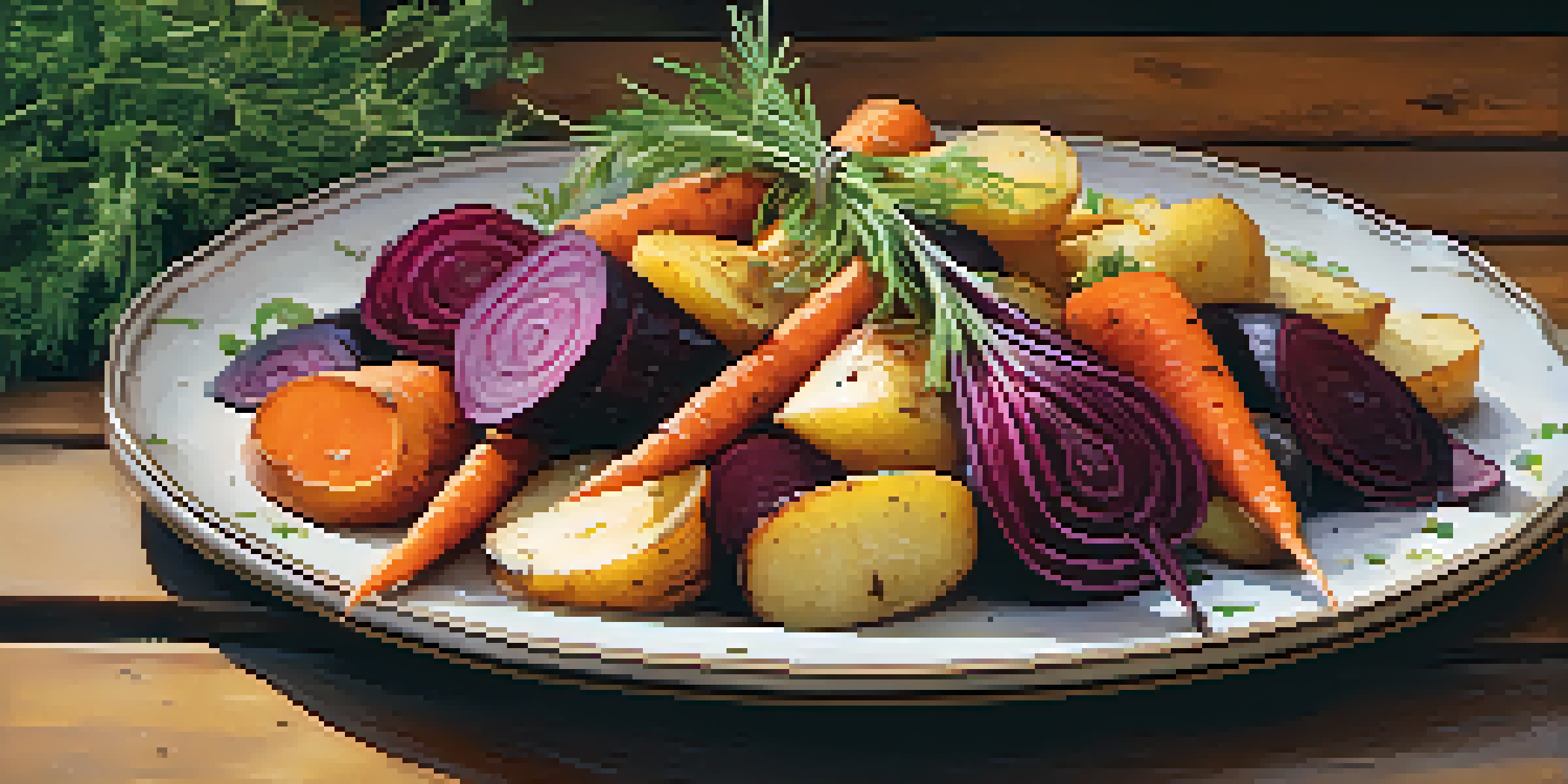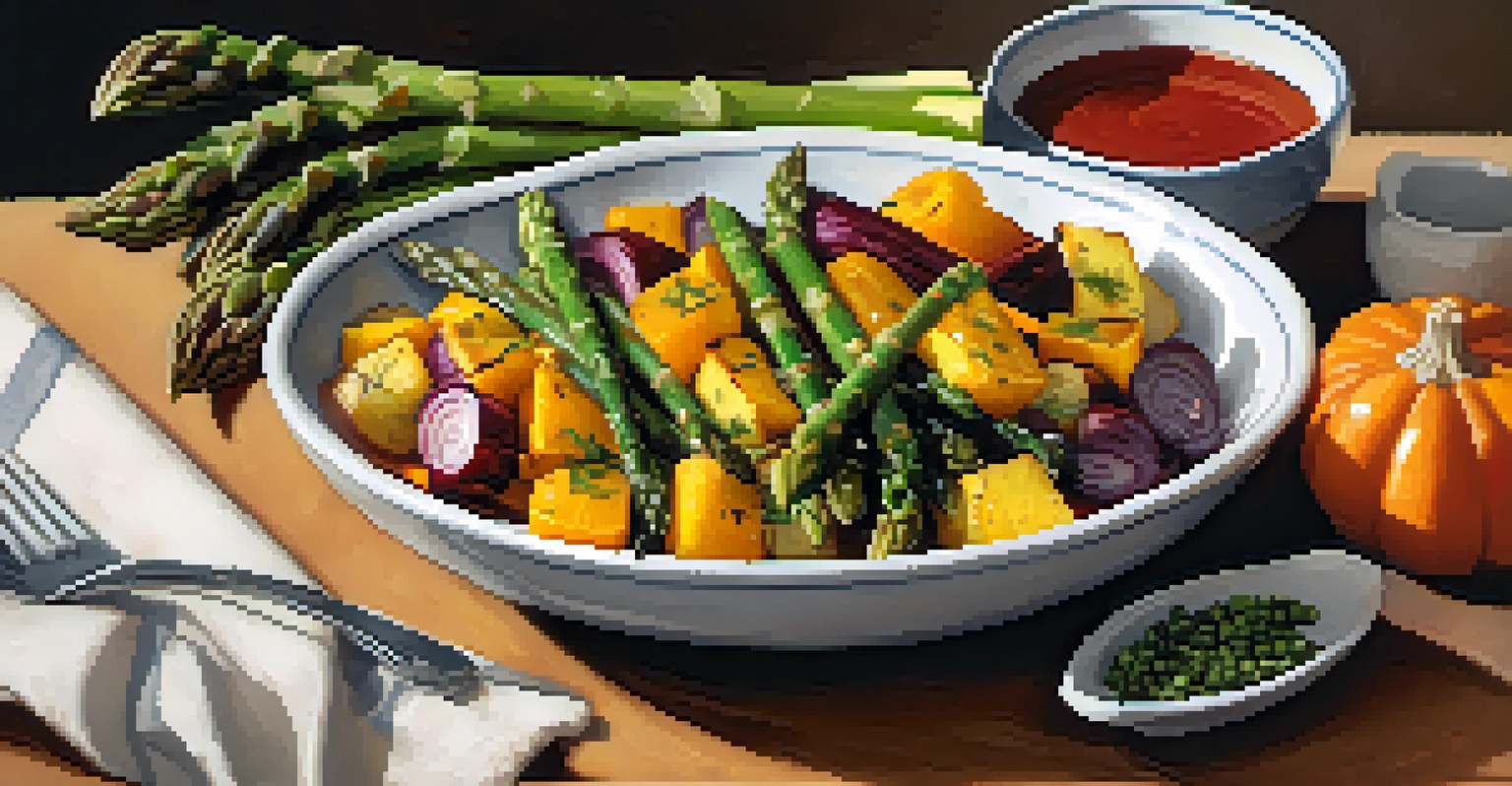Roasting Veggies: Tips for Perfect Vegan Meals Every Time

Choosing the Right Vegetables for Roasting
When it comes to roasting veggies, selecting the right types is crucial. Root vegetables like carrots, potatoes, and beets tend to caramelize beautifully, enhancing their natural sweetness. On the other hand, cruciferous vegetables like broccoli and Brussels sprouts develop a delightful crunch and depth of flavor when roasted.
Cooking is like love; it should be entered into with abandon or not at all.
Don’t shy away from experimenting with seasonal veggies! For instance, squash in the fall or asparagus in the spring can elevate your meal. Each season brings a new palette of flavors and textures, ensuring your roasted dishes never get dull.
Remember, the size and cut of your veggies matter, too. Uniform pieces will roast evenly, preventing some from burning while others remain undercooked. Aim for pieces about the same size for the best results.
Preparing Your Vegetables for Roasting
Preparation is key to achieving perfectly roasted veggies. Start by washing your vegetables thoroughly to remove any dirt or pesticides. Then, peel or trim them as needed, ensuring they’re clean and ready to shine.

Next, cut your veggies into uniform sizes. This not only helps them cook evenly but also makes for an attractive presentation. Think about how each vegetable cooks; for instance, denser vegetables might need smaller pieces compared to softer ones.
Choose the Right Veggies to Roast
Selecting root and cruciferous vegetables enhances flavor and texture when roasted.
Lastly, don’t forget to pat them dry! Excess moisture can lead to steaming rather than roasting, which isn’t the texture we’re aiming for. A little moisture is okay, but dry veggies will roast to crispy perfection.
The Magic of Seasoning Roasted Vegetables
Seasoning can make or break your roasted veggies. A simple drizzle of olive oil, salt, and pepper can elevate your dish significantly. But why stop there? Experiment with herbs and spices like garlic powder, paprika, or rosemary to find your favorite combinations.
The greatest dishes are very simple.
Don’t shy away from adding acidity! A splash of lemon juice or balsamic vinegar after roasting brightens the flavors and adds a refreshing contrast. It’s amazing how a little zing can transform the taste profile of your meal.
For a touch of sweetness, consider adding a sprinkle of maple syrup or agave nectar before roasting. This can create a beautiful glaze on your veggies, making them even more irresistible.
Finding the Perfect Temperature for Roasting
The ideal roasting temperature usually hovers around 400°F to 425°F (200°C to 220°C). This range allows for that lovely caramelization while ensuring your veggies cook through. Going too low can result in soggy vegetables, while too high can lead to burnt edges.
Preheating your oven is essential. A hot oven helps seal in moisture and develops that excellent crispy exterior we all love. Give your oven at least 15 minutes to reach the desired temperature before sliding in your tray of veggies.
Perfect Your Roasting Technique
Uniform cutting, proper seasoning, and maintaining the right temperature are key to achieving crispy, flavorful roasted vegetables.
If you’re roasting a mix of different vegetables, keep in mind that some may require longer cooking times. You might want to add denser veggies like carrots earlier than quicker-cooking ones like zucchini.
Using the Right Equipment for Roasting
Your choice of roasting pan can impact the outcome of your veggies. A rimmed baking sheet or roasting pan is ideal, allowing for even airflow around the vegetables. Avoid overcrowding; give them space to breathe for a perfect roast.
Consider using parchment paper or a silicone baking mat for easier cleanup. These surfaces help prevent sticking while also promoting even cooking. Plus, they make the post-meal washing up a breeze!
Don’t forget about utensils! A sturdy spatula or tongs can help you turn your veggies halfway through cooking, ensuring all sides get that delicious golden color.
Timing and Turning: Key Steps for Perfect Roasting
Timing is everything when it comes to roasting veggies. Most will need about 20 to 30 minutes in a hot oven, but this can vary based on the type and size of the vegetable. Setting a timer can help prevent overcooking.
Turning your veggies halfway through the cooking time is crucial. This ensures that all sides are exposed to the heat, promoting even browning. Use your spatula or tongs to give them a gentle toss.
Get Creative with Leftovers
Leftover roasted veggies can be repurposed into salads, soups, or frittatas, reducing waste and adding flavor to new meals.
Remember to peek in on them as they roast! If they’re browning too quickly, you can always lower the oven temperature slightly or cover them with foil for the remaining cooking time.
Creative Serving Ideas for Roasted Vegetables
Once your veggies are perfectly roasted, it’s time to think about how to serve them. They can be a fantastic side dish, but don’t overlook their potential as the star of the meal! Toss them into salads, grain bowls, or even as a filling for wraps.
For a delicious appetizer, serve roasted veggies with a tasty dip like hummus or a vegan yogurt-based sauce. The contrast in texture and flavor makes for an inviting starter.

You can also blend them into soups or purees for a comforting meal. The depth of flavor from roasted vegetables adds a richness that can elevate simple dishes into something special.
Storing and Reheating Leftover Roasted Vegetables
Leftover roasted veggies can be a treasure for future meals. Store them in an airtight container in your refrigerator for up to five days. They make for quick additions to meals, reducing cooking time during busy weekdays.
When reheating, a quick toss in a preheated oven or air fryer can help regain some of that crispy texture. Alternatively, a skillet on medium heat with a drizzle of oil can also work wonders.
If you’re feeling adventurous, incorporating your leftovers into a frittata or stirring them into pasta can create a whole new dish. It’s a great way to minimize food waste while enjoying a delicious meal!